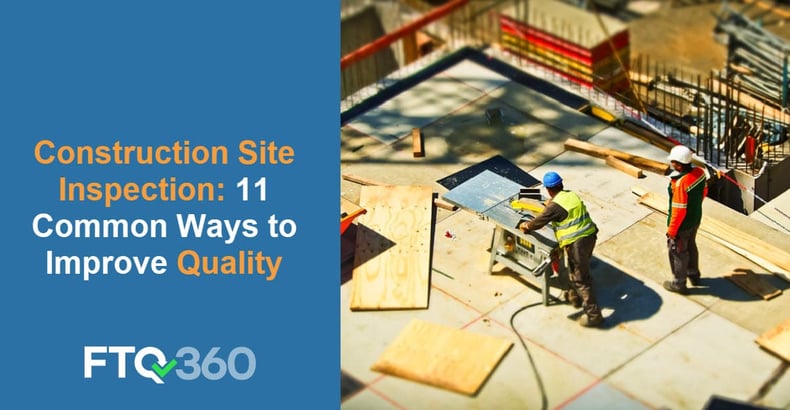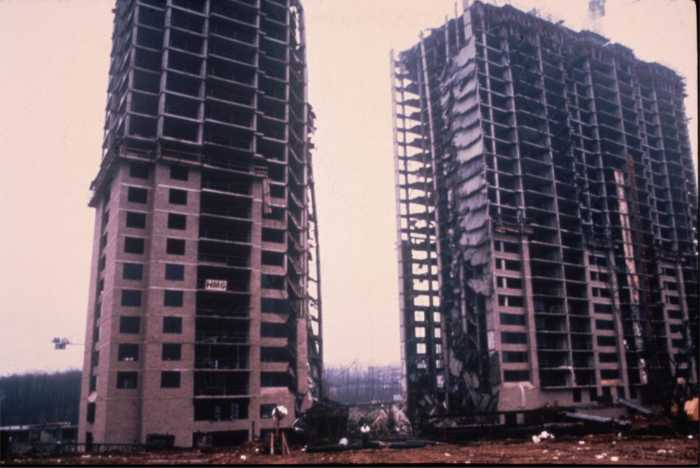
Effective construction site inspections are critical to ensuring quality, safety, and regulatory compliance. Whether you're performing daily walkthroughs or milestone-based audits, knowing how to inspect a construction site properly can prevent costly issues and improve project outcomes.
An investigation report by the American Society of Civil engineers that investigated 600 construction failures, including the Skyline Plaza Apartment Building in Virginia, found that the lack of quality control inspections was a cause of project failure.

(Skyline Plaza Apartment Building, Image source: ascelibrary.org)
What Is a Construction Site Inspection?
A construction site inspection is a systematic process used to evaluate the safety, quality, and compliance of ongoing work at a construction site. These inspections help ensure that construction activities follow approved plans, meet building codes, and adhere to health and safety regulations such as OSHA standards.
Site inspections are conducted at various stages of a project, from pre-construction through to project closeout and may focus on different areas including structural integrity, equipment use, workmanship quality, and hazard identification. Depending on the size and scope of the project, inspections can be performed daily, weekly, or at key milestones.
The goal of a construction site inspection is to detect and resolve issues early, reduce the risk of costly rework or accidents, and maintain control over project quality and timelines. When done consistently and thoroughly, inspections provide a critical foundation for successful project delivery and regulatory compliance.
How to Inspect a Construction Site – 11 Proven Techniques
Below are 11 ways to improve quality during a construction inspection.
1. Build inspections into the construction quality plan
Too often, construction site inspections are treated as separate processes instead of being built right into the project plan. By integrating construction site inspections into the quality plan from the outset, construction teams can ensure that quality is built into every aspect of the project scope from the ground up. This approach also allows for more efficient use of resources, as inspections can be scheduled and carried out in a more streamlined fashion. In addition, by making construction site inspections part of the quality plan, construction teams can send a clear message to all stakeholders that quality is a top priority.
2. Conduct regular inspections
By conducting daily site inspections and regular inspections pre-construction, during the construction process, and during project closeout, construction managers develop confidence that the project is progressing properly and can identify potential problems early and take corrective action to prevent them from becoming serious issues. By scrutinizing every aspect of the construction site, from the condition of the equipment to the way in which the work is being carried out, construction managers can ensure the quality of the work is up to scratch.
3. Use field-proven inspection checklists
Sometimes inspectors perform a simple walkaround which is not ideal with too many unknowns about what was inspected or even what was found to be good. When using construction inspection checklists these problems are avoided. There is no need for reinventing the wheel. Field-proven checklists ready for you to use and adapt can save you precious time. Having a checklist ensures that you won't forget anything important during the construction site inspection process.
4. Ensure inspections are consistent
Simple walkaround inspections can often be inconsistent, with different inspectors looking for different things. This can lead to construction sites passing inspection despite having serious safety or quality issues. To ensure that construction site inspections are consistent, building regulation inspections, health and safety standards, and quality management should be incorporated into the inspection process.
Construction managers should develop a checklist of items that must be verified at each milestone, including health and safety standards and quality management practices. Checkpoints requiring photo documentation or actual measurement data can also help make sure the verifications themselves are carried out correctly.
Using the checklist as an inspector training tool goes a long way to make sure all inspectors look for these items and document their construction project findings consistently and in the same format.
5. Assign accountability for inspections
One way to improve the quality of inspections is to assign accountability for construction inspections. This can be done in a number of ways, including assigning specific inspectors to specific tasks or requiring that inspectors submit written reports after each construction inspection. By holding inspectors accountable for their work, it is possible to ensure that construction site inspections are carried out thoroughly and effectively.
6. Document critical project compliance details
By documenting critical project compliance details, construction site inspectors can help to ensure that the project meets all required standards. There are a number of different ways to document critical project compliance details. The foundation of project compliance documentation are the inspection reports that are made throughout the project lifecycle with specific compliance details well documented.
Digital inspection reports create a database of construction inspections that occur throughout the project. This database includes information on the date and time of the inspection, the location of the inspection, the type of work being inspected, and the specific compliance details that were documented.
7. Include photographic evidence
Photographs can provide a clear record of the construction site, highlighting any areas of concern. They can also be used to track progress over time, helping to ensure that the construction project is on track. Including photographs in construction site inspection reports can help to improve the quality of the inspection process and ultimately lead to a better outcome for the construction project.
8. Ensure you adhere to OSHA-compliant safety reporting
Poor safety protocols can undermine construction project quality. It is also an opportunity to verify safety requirements are in place while inspecting for quality. Therefore, when conducting construction inspections, it is important to ensure that all safety hazards are reported on inspection reports in accordance with OSHA regulations.
9. Analyze field reports carefully to uncover root-causes
By understanding the reasons for construction defects, it is possible to put systems and controls in place to prevent them from happening again. Poor workmanship, for example, can often be addressed by targeting quick response workforce training on specific issues so that problems found in early in the project are lessons learned that can prevent the same problem elsewhere on the project.
10. Alert inspectors to high-priority checkpoints
One way to improve quality during a construction site inspection is to alert inspectors to high-priority checkpoints. These checkpoints are typically areas where there is a high risk of errors or where previous problems have been found. For example, a high-priority checkpoint at a construction site might be critical anchor locations in concrete, where positioning mistakes can cause very costly rework. Another example might be the roof, where junction details can pose a risk of leaks if not implemented properly.
11. Follow-up for issue correction
Finally, it beats logic to conduct an inspection and then fail to follow up on the issues that were found. Unfortunately, this appears to be a very common problem, and it usually occurs due to a breakdown in communication. There are numerous examples of disasters that could have been averted if only someone had followed up on an inspection report. It is vital to streamline the construction team's communication.
Why Construction Site Inspections Fail – Common Pitfalls
Despite being a routine part of project management, construction site inspections often fail to catch critical issues. These failures are rarely due to a lack of effort—instead, they typically result from preventable oversights in planning, execution, or communication.
Here are the most common pitfalls that cause site inspection failures:
1. Lack of Standardized Checklists
Without a consistent inspection checklist, different inspectors may focus on different elements, leading to gaps in coverage. This inconsistency increases the risk of missing major safety hazards or quality defects.
2. Inadequate Inspector Training
When inspectors are not properly trained or aligned on what to look for, the effectiveness of the inspection suffers. Proper onboarding and continuous training are critical to maintaining inspection quality.
3. Poor Documentation Practices
If inspection findings are not clearly documented, with photos, measurements, or compliance notes, it becomes difficult to verify what was inspected or take corrective action. Incomplete records also reduce accountability.
4. No Follow-Up on Identified Issues
Many inspections fail not during the walkthrough, but after it. If issues are documented but no action is taken, the inspection serves little purpose. Lack of follow-up creates a false sense of compliance and can lead to repeat failures.
5. Overlooking High-Risk Areas
High-risk elements of a project, such as structural reinforcements, waterproofing, or safety installations—often require specialized attention. When these are treated the same as low-risk areas, critical errors can go unnoticed.
6. Disconnected Safety and Quality Processes
When safety inspections and quality inspections are handled separately, key overlaps may be missed. A unified inspection approach ensures that both compliance and workmanship are evaluated holistically.
Avoiding these common pitfalls requires a proactive inspection process, backed by the right tools, trained personnel, and a commitment to follow through on findings.
A digital inspection platform like FTQ360 can help standardize your inspections, ensure accountability, and reduce the chances of costly oversight.
How FTQ360 Helps Streamline Site Inspections
In today's construction industry, quality is paramount. That's why it's so important to have a tool in place that can help you manage construction inspections. FTQ360 has all the 11 processes above built into the tool. Our software is designed to help you improve the quality of construction projects.
For more information, try out a free demo and see how FTQ360 can help you streamline your construction site inspection process.
![[FREE EBOOK] Your Complete Guide to Achieving First Time Quality](https://no-cache.hubspot.com/cta/default/3353989/725fa3fc-ef19-4a96-a65f-0bdb4e982a78.png)
